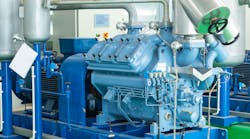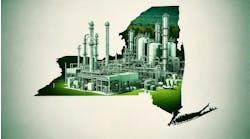In last month’s column, “Speak the Language of Energy Efficiency,” we saw how the simple Carnot efficiency equation, η = 1-Tc/Th, can provide many insights into the design and operation of some of the most common power-generating equipment — heat engines, including steam turbines, gas turbines and internal combustion engines. In the power-generating step of their operating cycle, they expand a hot, pressurized gas, lowering its pressure and temperature, with or without phase change. Another common device — the mechanical refrigerator or vapor-compression refrigeration system — does the opposite.
Vapor-compression refrigeration systems have a wide range of applications, from domestic and commercial refrigerators, air conditioners, water coolers, refrigerated trucks and railroad cars to large-scale applications — many of which are at much lower temperatures — in chemical and petrochemical plants, oil refineries and gas processing plants. Depending on the application, they may use a variety of working fluids (refrigerants), including ammonia, various hydrocarbons, and hydrofluorocarbons (HFCs).
In the simplest form of these systems, liquid refrigerant is depressurized into an evaporator, which also serves as the sink to remove heat from (and thus refrigerate) the material or the space needing to be cooled. The combination of pressure reduction and heat input causes the refrigerant to vaporize; the operating pressure dictates the refrigeration temperature. The vapor then enters a mechanical compressor, which boosts its pressure to a level that allows the vapor to condense against an external coolant (usually air or water, at close to ambient temperature) in a condenser. From here, the refrigerant is again depressurized and returned to the evaporator to restart the cycle.
Consider a vapor-compression refrigeration system as a heat engine running backwards, thus the Carnot efficiency equation can work here. However, the conventional definition of energy efficiency (useful energy out/total energy in) isn’t very helpful when we consider refrigeration. A more useful parameter is the “coefficient of performance for refrigeration,” COPr, where COPr = useful cooling provided/work required. We can rearrange the Carnot efficiency equation for this application:
COPr,ideal = Tc/(Th-Tc)
Here, COPr, ideal is the coefficient of performance for an ideal refrigeration system, with any given refrigeration temperature (Tc, the cold end of the cycle) and corresponding heat rejection temperature (Th, the hot end of the cycle), both expressed on an absolute scale. High values of COPr (whether ideal or not) correspond to the most efficient operation, as they maximize useful cooling while minimizing the work requirement. However, unlike conventional efficiencies, COPr can attain values greater than 1 (or 100%); by inspection of our equation, COPr, ideal > 1 if Tc > ½Th.
The actual values of COPr with real refrigeration systems are much lower — typically 50% or less of the ideal value. Nevertheless, just as we found for heat engines, the ideal equation provides hints at how we can improve the efficiency of both the design and the operation of real equipment. First, we seek to eliminate or minimize the non-idealities of our system, then we consider how we can manage the parameters in the equation to maximize COPr.
Ideal heat transfer occurs without any temperature difference, but that’s not the case for real heat transfer. Designing the evaporator and condenser in our refrigeration system with the smallest practical temperature differences (subject to technical and economic constraints) reduces non-ideality, and we operate and maintain them to keep them clean. Likewise, we minimize unnecessary frictional losses; energy efficiency is a key factor when choosing the working fluid and compressor.
COPr increases as Tc increases and Th decreases. Lowering the temperature of the external cooling medium reduces Th (the condenser temperature). This favors the use of cooling water over air; we design and operate the cooling towers for the closest practical approach to dew point. The temperature to which we need to cool our process largely controls Tc (the evaporator temperature). However, many process streams are refrigerated over a wide temperature range, for example, from 80°F to -180°F. We could use a refrigeration temperature a few degrees below -180°F to do all of the cooling. However, we can save energy by cooling in stages, using cooling water to remove as much heat as possible, and then refrigeration at progressively lower temperatures (say, 0°F, -100°F and -185°F). There is a trade-off, however: Increasing the number of stages saves energy but increases investment and adds complexity.



